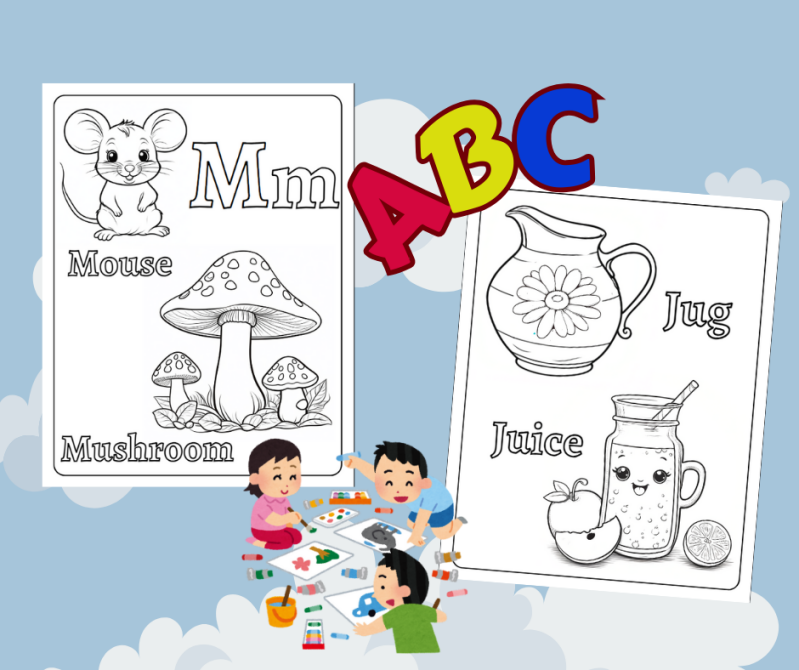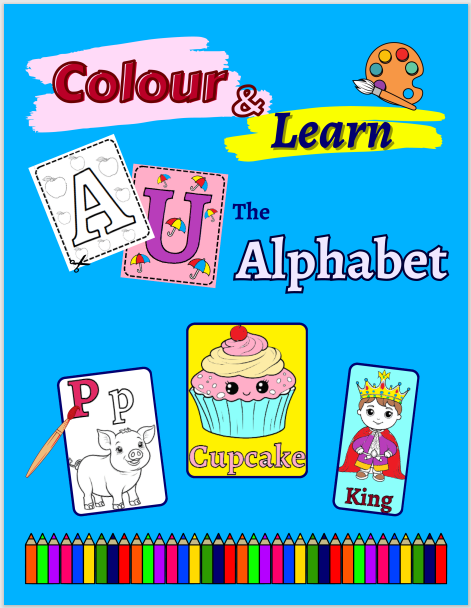Learning the alphabet is a crucial milestone in early childhood development, and making the process enjoyable can significantly enhance your child’s learning experience. By incorporating fun and creative activities at home, parents can help their children master the alphabet while also building a love for learning. Here are five engaging activities you can do with your child to support alphabet learning at home.
5 Fun Activities to Support Alphabet Learning at Home

This post contains affiliate links. If you make a purchase through these links, I may earn a small commission at no additional cost to you. Thank you for supporting my website!
1. Alphabet Colouring Pages
Colouring is a timeless activity that children love, and it can be a powerful tool for alphabet learning. Alphabet colouring pages allow your child to associate letters with images, making it easier for them to remember each letter. For example, your child can colour a page featuring the letter "A" along with an apple, or the letter "B" with a bus. This visual association helps cement the connection between the letter and its corresponding sound.
How to Do It:
- Print out or purchase an alphabet colouring book designed specifically for children (like the one created by me :), where beside alphabet colouring pages, you can find letters to colour and cut out, perfect for decorating a room or adding to playtime activities)
- Encourage your child to say the letter and the word aloud as they colour.
- As they colour, talk about the sound the letter makes and other words that start with the same letter.
This activity not only reinforces letter recognition but also supports fine motor skills and creativity.
2. Alphabet Scavenger Hunt
Turn learning into an adventure with an alphabet scavenger hunt! This activity is perfect for getting your child moving and thinking as they search for items around the house that start with each letter of the alphabet.
How to Do It:
- Write down the alphabet on a piece of paper or create a checklist.
- Start with a specific letter, such as “A,” and ask your child to find something in the house that begins with that letter (e.g., apple, apron).
- Once they find an item, move on to the next letter until you’ve gone through the entire alphabet.
To make it more challenging for older children, set a timer and see how many items they can find within a certain time limit. This activity not only reinforces letter sounds but also sharpens observation and categorization skills.
3. Letter Matching Games
Letter matching games are an excellent way to help your child recognize and remember both uppercase and lowercase letters. These games are simple to set up and can be done with homemade or store-bought materials (like this one or this one for example)
How to Do It:
- Write each letter of the alphabet on two separate cards: one for the uppercase letter and one for the lowercase letter.
- Spread the cards out face-down and take turns flipping over two cards at a time, trying to find the matching pairs.
- When a match is found, say the letter aloud and talk about words that start with that letter.
For a more interactive version, you can also match letter cards to objects around the house that start with the corresponding letter. This reinforces both letter recognition and phonemic awareness.
4. Alphabet Playdough Mats
Playdough mats are a tactile and creative way to help your child learn the alphabet. These mats typically have the outline of a letter that your child can fill in with playdough, helping them learn the shape of each letter while engaging in a fun, hands-on activity.
How to Do It:
- Create or print out playdough mats with each letter of the alphabet.
- Provide your child with playdough in various colors and encourage them to roll it out and shape it to fit the letter on the mat (like this one or this one for example)
- As they mold the playdough into the shape of the letter, say the letter aloud and discuss its sound and some words that begin with that letter.
This activity is great for reinforcing letter recognition and building fine motor skills, all while giving your child a chance to express their creativity.

5. Alphabet Song with Movements
Music and movement are powerful tools in learning, and combining the two can make alphabet learning more memorable and fun for your child. Singing the alphabet song with added movements can help your child connect the letters with their corresponding sounds and sequences.
How to Do It:
- Sing the traditional alphabet song with your child, but add a twist by incorporating movements. For example, you can:
- Clap for each letter.
- Jump for vowels.
- March in place for each letter.
- To further reinforce learning, try creating a dance move for each letter based on its shape (e.g., making a circle with your arms for “O” or standing tall and straight for “I”).
This multi-sensory approach engages different parts of your child’s brain, helping them to better retain the information and making learning the alphabet an enjoyable experience.



Reinforcing alphabet learning at home doesn’t have to be a chore—it can be a fun and enriching experience for both you and your child. By incorporating these five activities into your daily routine, you’ll help your child develop a strong foundation in letter recognition, phonics, and early literacy skills. Remember, the key to successful learning at this age is making it engaging and enjoyable, so feel free to get creative and adapt these activities to suit your child’s interests and learning style. Happy learning!

Add comment
Comments